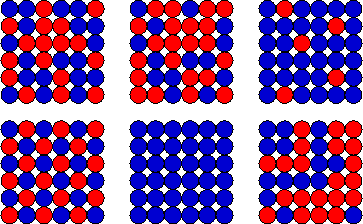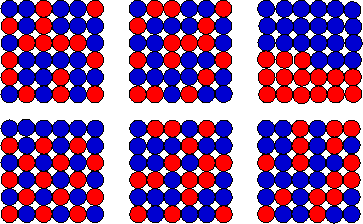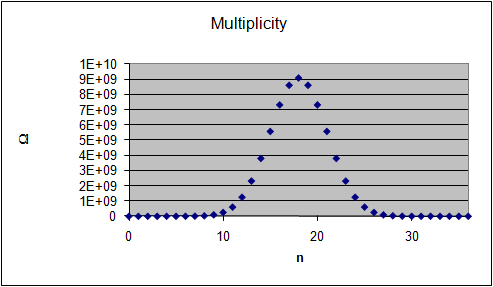

In-class group activity 14:
Discuss and answer all questions (blue font color).
Open a Microsoft Word document to keep a log of your results and discussions.
(a) Assume 50 students registered for a course. You need to report the total number of students who actually attend. You have every student in attendance sign a list.
(b) Consider the following macrostates of the class.
| (c) Assume you have two boxes and you have to place a coin into each box. You toss a coin and place it into box 1 without changing its orientation. The side of the coin facing up can be either head (blue) or tail (red). Then you toss a second coin and place it into box 2 without changing its orientation. There are 4 different microstates. You are interested in the different configurations, ie e. you are interested in how many coins end up "head up" or blue. |
 |
| (d) Now assume that you have a 6 by 6 array of squares.
You number the squares from 1 to 36. You toss a coin and place it
onto square 1 without changing its orientation. The side of the
coin facing up can be either head (blue) or tail (red). You keep
tossing coins and placing them in succession onto squares 2 through 36
without changing their orientation. Each square holds exactly one
coin. (The macrostate is 36 coins on 38 squares.) To specify the microstate of the array after you finished this process you have to list the color of each square. Many different patterns (microstates) are possible, such as the ones shown on the right. Every particular pattern is equally likely to occur. There are 236 = 6.87*1010 possible patterns and the probability of observing any particular pattern is 1/236 = 1.46*10-11. |
 |
| Suppose you are only interested in the
configuration,
i.e. you are only interested in how many squares are blue. Most
configurations correspond to many microstates. A few of the allowed
microstate for the “15 blue squares” configuration are shown on the right. How many microstates are there for a given configuration? This is the common problem of splitting a group of N into two smaller groups, of n and N - n, without caring about the ordering in each group. The number of ways of doing it is N!/[n!(N-n)!]. Assume you have N colored objects, but n of them are “special”. They could, for example be blue, while the other N - n objects are not blue (red). There are N*(N - 1)*(N - 2)*…*2*1 = N! ways of distributing the n blue and N - n red objects over N places. [For the first object you have N choices. But now one place is occupied. For the next object you only have N - 1 choices, etc.] But for each of these distributions there are n! ways of arranging the blue objects among themselves without changing the pattern, and there are (N - n)! ways of arranging the other (red) objects among themselves without changing the pattern. Therefore the number of distinct patterns you can produce is N!/[n!(N-n)!]. In our example N = 36. If n = 15 there are 5.56*109 distinct patterns that have 15 blue squares. There are 5.56*109 distinct microstates for the n = 15 configuration. If n = 10, there are only 2.54*108 distinct patterns. The n = 18 configuration has the maximum number of microstates, namely 9.08*108. Since every microstate is equally likely and the total number of microstates is 2N, the probability of observing a given configuration (n out of N) is N!/[2Nn!(N-n)!]. |
 |
| The graphs on the right show the multiplicity Ω for
each "n out of 36" configurations and the probability of observing this
configuration. (See the
attached spreadsheet.)
The probability of observing a configuration n <7 or n > 30 is practically
zero. Answer the multiple choice question below: If we examine the probabilities for all of the configurations in the system we find that the probability is
How does this behavior scale with the number of coins N?
As the number of particles grows, the probability of observing the most likely configuration becomes nearly indistinguishable from 1. |

|
(